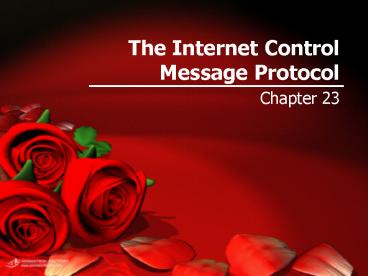The Internet Control Message Protocol - PowerPoint PPT Presentation
1 / 26
Title:
The Internet Control Message Protocol
Description:
In TCP/IP there is no intelligence in the network ... Datagrams are prevented from circling forever by TTL. ICMP time exceeded message ... – PowerPoint PPT presentation
Number of Views:115
Avg rating:3.0/5.0
Title: The Internet Control Message Protocol
1
The Internet Control Message Protocol
- Chapter 23
2
ICMP
- In TCP/IP there is no intelligence in the network
- Thus, if something fails, there is no easy way to
report that failure - A special message mechanism allows routers to
report nasty events
3
Reporting or Correction?
- Errors are reported, but they are not corrected
- Errors about error messages are not reported for
obvious reasons - Errors are reported to IP software, not to a
particular protrocol - Errors are reported to the source
4
Examples
- A Header Checksum Error
- The datagram must be discarded
- Why?
- Less severe errors involve ICMP
- IP type 1
- IP uses ICMP and ICMP uses IP
5
A List of ICMP Messages
6
Examples - I
- Source Quench
- A router has run out of buffer space and must
discard datagrams - When it discards a datagram, it sends a source
quench message to the host that created the
datagram. Why that host? - The host must reduce its transmission rate
7
Examples - II
- Time exceeded.
- TTL field gets to zero
- Datagram discarded
- ICMP message is sent
- Destination Unreachable
- When a router discovers that a datagram cannot be
delivered, it sends a message - Network unreachable
- Host unreachable
8
Examples - III
- Redirect causes a host to change its route
- Eg, the extra hop problem
- Parameter problem
- Echo request/reply
- Address Mask request/reply
- A host boots and needs to know the network mask
9
ICMP Message Transport
- ICMP uses IP
- Encapsulation
- Error messages and replies are sent to the
sending host - No special priority
- No error messages sent when ICMP messages are
dropped
10
Ping and Traceroute
- Ping tests reachability!
- Traceroute sends datagrams with TTL varying from
1 to n - At each host that discards one of these
datagrams, an ICMP time exceeded message is sent - Most useful in a stable internet
11
Traceroute - The Last Address
- Two ways to do traceroute
- Send ICMP echo request messages
- Send a datagram to a non-existent service (port)
- Windows use the first approach, and always uses
the information the user typed on the command
line - Unix uses the actual interface on which the
datagram arrived - Two answers are possible for a multi-homed host
12
Path MTU Discovery
- IP software sends a sequence of probes with the
Dont Fragment bit set - If it arrives at the destination, then that
datagrams size is acceptable - If not, the software reduces the size of the
datagram and retries
13
Echo Request and Reply Format
- Type (8 or 0)
- Code
- Checksum
- Identifier
- Sequence Number
- Optional Data
14
Unreachable Destinations
- Type is 3
- First 64 bits of the datagram
- Code
- 0 network unreachable
- 1 host unreachable
- 2 protocol unreachable
- 3 port unreachable
15
Codes (continued)
- 4 fragmentation needed and DF bit set
- 5 source route failed
- 6 destination network unknown
- 7 Destination host unknown
16
Congestion and Flow Control
- Because IP is connectionless, there is no way to
reserve resources on routers in advance - As a result routers can be overrun with traffic
17
Congestion
- A computer may be able to generate traffic faster
than a network can transfer it - If many computers simultaneously need to send
datagrams through a single router, the router may
experience congeston
18
Whats a Router to do?
- Small bursts can be solved by buffering
- If traffic continues, a source quench message is
sent to the original source to reduce its rate of
transmission
19
More Sophisticated Routers
- Monitor incoming traffic and quench sources with
the highest rates - Send requests before the queue actually overflows
20
Congestion (continued)
- There is no ICMP message to reverse the effect of
a source quench - A source lowers its rate until it stops receiving
quench messages and then gradually increases the
rate - Rely on higher level protocols!
21
Source Quench Format
- Type 4
- Code 0
- Checksum
- Unused
- Internet Header first 64 bits
22
Route Change Requests
- Routers are assumed to know correct routes
http//www.calvin.edu/lave/figure-8.7.pdf - Hosts begin with minimal routing information and
learn new routes from routers - ICMP redirect allows a host to boot knowing the
address of only one router
23
Code Field in a redirecct
- 0 redirect for the net (obsolete)
- 1 redirect for the host
- 2 redirect for the type of service and net
- 3 redirect for the type of service and host
24
Circular or Excessively Long Routes
- Datagrams are prevented from circling forever by
TTL - ICMP time exceeded message
- Code 0 Time-to-live count
- Fragment reassembly time exceeded
25
Reporting Other Problems
- ICMP parameter problem message
- Only severe problems
- Arguments to an option are incorrect
- Pointer field identifies the octet that caused
the problem
26
Clock Synchronization and Transit Time Estimation
- ICMP timestamp request message
- Time in milliseconds since midnight Universal
Time - Round trip delay can be difficult to estimate
- Varies greatly
- averaged































